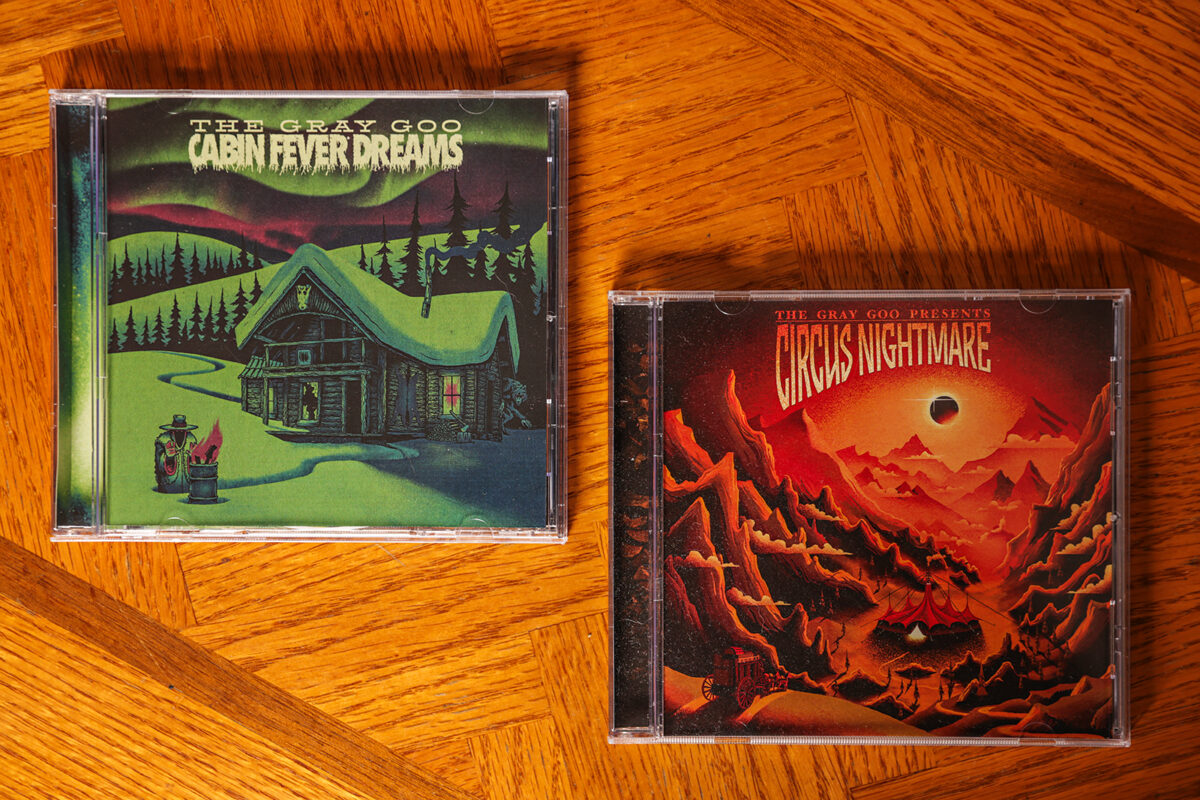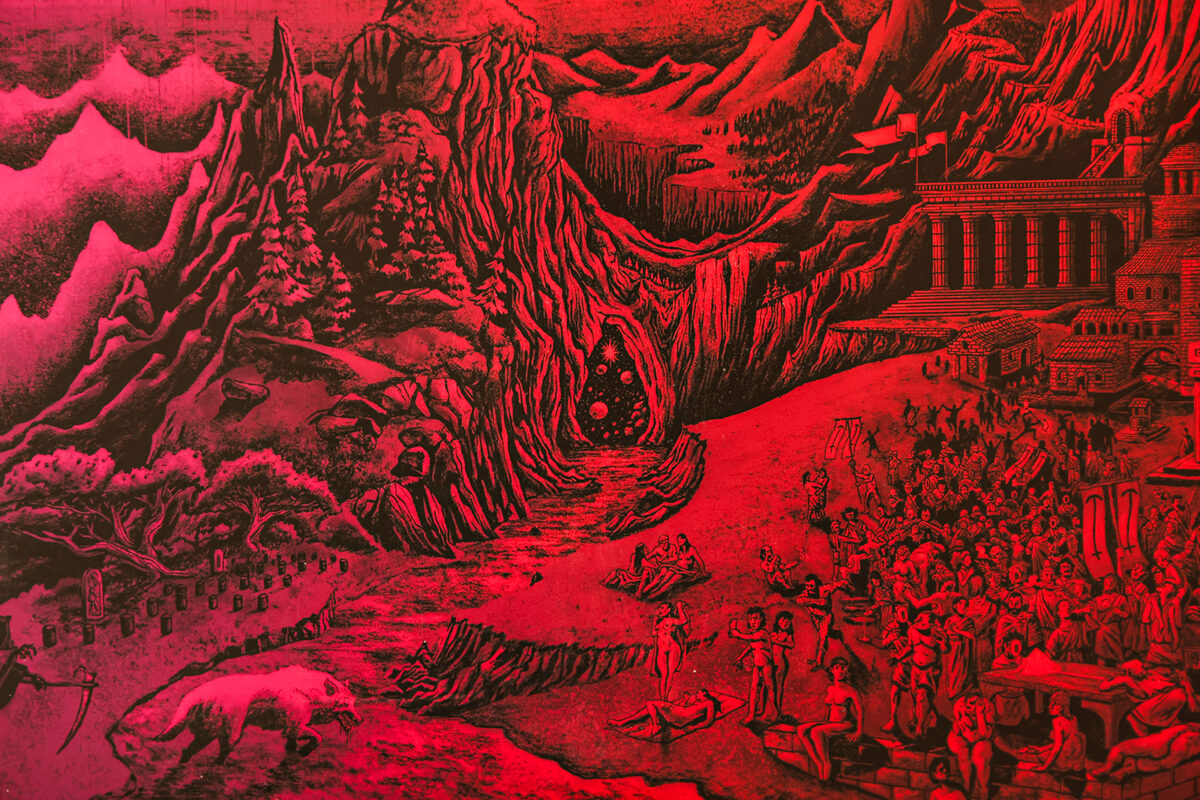One Image at a Time, Illustrator Isaac Passwater Tells Stories of Horror, Science Fiction and Fantasy
These days one of the most recognizable outlets for Passwater’s otherworldly interests and passion for illustration comes in the form of concert posters, merch and especially album art
By Mike Kordenbrock
In trying to narrow down the exact moment that Bigfork area illustrator, artist and graphic designer Isaac Passwater’s love for drawing fused with his love for horror, science fiction and fantasy, there are a couple likely suspects.
A good starting point might be the first time he saw the 1990 horror comedy “Tremors” as a kid. Set in the American southwest, the movie follows the efforts of Valentine McKee (Kevin Bacon) and Earl Basset (Fred Ward) and a wider cast of characters as they try to get to the bottom of unexplained deaths near the dusty town of Perfection.
Those deaths are eventually revealed to be the work of a group of subterranean worm-like creatures called graboids, which tend to reveal their approach with a distinct Etch-A-Sketch-like furrow of raised earth.
The $6 million movie is filled with relentless, bloodthirsty monsters, goofy moments and laughably bad dialogue. A trailer running less than two minutes contains deep observations like “That’s how they get you, they’re under the ground” as well as zingers like “Who died and made you Einstein?” and “I vote for outer space. No way these are local boys.”
“Tremors” has a decidedly low-budget feel, at least when viewed from the present, and it’s movies on that schlocky, funny but still scary end of the horror-thriller spectrum — occupied at times by directors like David Lynch and John Carpenter — that Passwater loves. And “Tremors” is one of the first he mentions as he thinks back to those impressionable early years. He also cites as formative flicks “Godzilla 2000,” “Jurassic Park,” and “Jaws,” and gives special honors to “Dog Soldiers,” a 2002 horror movie about soldiers beset by a pack of werewolves while training in the Scottish Highlands.
When Passwater saw “Dog Soldiers,” he said he was about 8 years old. “Probably a little young for it,” he concedes, but he still relishes that feeling of a movie that was a lot of fun, but could still keep him up at night. At the same time, Passwater grew up in Bigfork as a self-described kid who was always doodling weird things in class.
These days one of the most recognizable outlets for Passwater’s otherworldly interests and passion for illustration comes in the form of concert posters, merch and especially album art for local metal bands, like The Gray Goo. The band’s often doom-filled and psychedelic subject matter has been a good creative match for Passwater, who has taken prompts from the band and created an array of sinister scenes often laced with comedic elements and overlaid with color schemes and design elements that produce a retro feel.

For their recent album “Cabin Fever Dreams,” Passwater used an aurora-borealis color palette to illuminate a scene of deep snow, backwoods desolation and perhaps impending doom. A character in the foreground clad in a heavy fur coat can be seen warming up at a burn barrel fueled by a guitar. In the background, a cabin lurks, with one window broken and another wearing a spray of pink. From around the back of the cabin, a werewolf looks out, and more red glowing eyes can be seen in the dark woods beyond.
“I think it makes people intrigued. The visual side of art is key to connect because we also listen with our eyes a lot, too,” Gray Goo guitarist Max Gargasz said of Passwater’s art. “I think that really helps shape the whole lore or aesthetic of the band. It kind of gives us a solid brand, which is super important for the band.”
A fan of metal and psychedelic music, Passwater happened to be at the Gray Goo’s first show at the 2021 Mosh in the Mountains festival in Libby. He introduced himself to Gargasz afterwards, and told him about his experience as a designer. The partnership blossomed from there, with Passwater designing the cover for the Goo’s first album “1943.”

That image, still one of Gargasz’s favorites, shows a trio of purple robed and hooded figures with faces shrouded in black and glowing teal eyes sharing a three-seater bicycle and making their way down a winding path leading away from a sinister castle in the distance.
The band gave Passwater a rough concept — a 1960s piece of psychedelic blotter art showing a cyclist in front of a mountain, and Passwater ran with it in a darker direction.
The multiple components of the cover art for “1943,” from the castle, to the winding path, to the hooded cyclists, and even the sun and a crescent moon simultaneously visible in a darkened sky, cumulatively suggest a supernatural, or at least inhuman element to the Gray Goo’s music. Creating an entire story from one illustration is what Passwater often aspires to do with his art, but it wasn’t always obvious to him that such a thing could be achieved.
Passwater graduated from Bigfork High School and studied art at the Minneapolis School of Art and Design, where he majored in illustration.
As a college student, Passwater dabbled into a range of mediums and methods, taking courses in typography, photography, filmmaking and graphic design. For a time he thought that he wanted to create comic books, and they remain a source of creative fuel, especially the “Hellboy” comics illustrated by Mike Mignola. Mignola’s approach involves dark shadows and simple shapes and images that collectively feed into the overarching feel of the comic and its story. It’s less about packing a thousand details into a frame, and more about whittling the visual imagery down to its essentials. “It feels kind of dark and brooding, like German expressionism, almost,” Passwater says.
Passwater took an interest in comic illustration in high school, but over time he found the volume of drawing and illustration it required to be a headache. “I’d rather tell a story in a single image, he said.
But it wasn’t always obvious how to do that. Hanging in Passwater’s home near Bigfork, a dwelling filled with DVDs, books, plants and art, is an illustrated poster depicting a panther in the moments before its life ends. The animal is shown from the shoulders up, rearing up from a dense stand of leafy tropical plants, and snarling towards the sky. Its paws are forward, caught somewhere between striking and defending, and from all angles arrows are closing in on the panther. One has pierced its right front paw, and another has gone through its head.

The complete story told in that image, made by illustrator and designer Jared Tuttle, stopped Passwater in his tracks, and made him rethink what he really wanted to do with his talents.
Passwater’s eventual post-grad return to the Flathead led to a multi-year period where he worked as a loader-operator at a gravel pit while doing illustration and design in his spare time. That work often involved crafting logos and designs that relied on western motifs.
“I was kind of going with the flow with everything else here, with Western stuff and cowboys. Which is fun sometimes. But it gets old,” Passwater said. Discovering local and regional bands whose themes delve into science fiction, horror and fantasy provided a solid reason for Passwater to create art in the genres he loves.
Now in his late 20s, for roughly the last four years Passwater has been working full-time as a graphic designer for Flathead-based Distillery Products, a company that designs and produces specialized engraved glassware for brands like Wild Turkey, Jack Daniels and Buffalo Trace. Part of Passwater’s work entails taking a design, or design concept, and working through it to determine how it can translate onto a design for a glass product.
When he’s not designing posters, merch and album art for the Gray Goo, or other psychedelic and metal bands like Wizzerd, Merlock and Los Toms, he plays music himself, saying that he has an interest in the cowpunk musicians of bygone decades.

When it comes to album art, Passwater tries to blend not only the concept he gets from his clients, but also the actual music on the album, as well as his own artistic sensibilities.
If an album has a frenetic feel to it, for example, then Passwater says “you want the album cover to feel like that.”
As part of his creative process, Passwater gathers images and creates mood boards, which also incorporate color compositions and can give a band an idea of where he might be going with his illustrations. Then he does numbered thumbnail sketches in order of his own preference, and sends a selection of those to a client, who can make the final call. After that comes a final sketch with a rough incorporation of color.
“From there, it’s just powering through and trying to get it done.” Having a deadline is important in reining in Passwater’s creative process. “If I don’t have a deadline, then it’ll get lost in the weeds for me.”
He puts in most of his work on a computer in a small home office, where bleached animal bones share space with a Godzilla figurine, and posters he’s designed hang from the walls.
Wading through the creative process and finding a solution is part of what Passwater enjoys about his work. He likens it to the process of learning an instrument, or struggling through a video game.
“You get that little dopamine hit where you’re like ‘Oh, I did it. That’s awesome, I need to do this more. And it’s the same thing with painting, where it’s like ‘What do they want me to do?’ They want me to draw a giant bulldozer retrofitted to be a giant bong?” Passwater says, referring to artwork he designed for the Gray Goo’s song “Chilldozer.” “Yeah, alright, I’ll figure that out. That headache is part of the fun.”